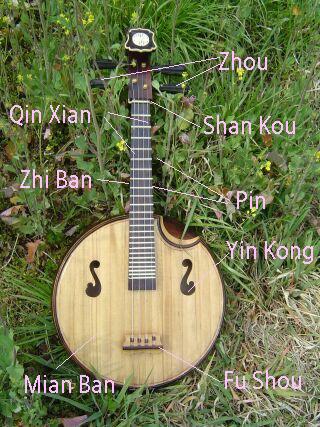Ruan
History
Ruan is a plucking instrument
that has a long history.
Once known as the Qin
Pipa or the Ruan
Xian in the past, it is part of the Tan Bo Yue (plucking instrument) family.
Dating
from the Han dynasty
between 140-87 BC, the Ruan was created based on the Qin,Zheng which are all
part of the Tan Bo Yue family. The name Ruan Xian came from the renowned scholar Ruan
Xian, a musician and one of the "seven Sages of Bamboo Grove" of the
3rd century (the Six Dynasties) who was adept in playing this instrument.
However due to the chaotic
situation at those times, the instrument was lost. It was not until Tang Dynasty
(AD 684~701) that the Ruan was rediscovered and subsequently named after Ruan Xian. The
Ruan became wildly popular among the people and during the Tang Dynasty; it was
even spread to Japan. Presently, the Nara Museum still holds a
Ruan from the bygone era.
The traditional Ruan did not
command much range. Since 1953, many improvements have made to the instrument,
including increasing the range and also the number of frets of the instrument.
Types
The present Ruan has 4 strings
and it has been expanded to form a family of 5, the Gao Yin Ruan(soprano Ruan),
Xiao Ruan(small Ruan), Zhong Ruan (alto Ruan), Da Ruan (tenor Ruan) and the Di
Yin Ruan (bass Ruan), a development intended to increase the range and the effectiveness in the modern Chinese orchestra. The alto and the tenor
Ruan are
commonly used. Plectrums or fingernails made from plastic or tortoise
shells are
needed in performances. Mellow in tone quality, the Ruan is often seen in ensembles or
in accompaniments, and more recently as a solo instrument.
There are more than 30 types of
right hand plucking techniques and more than 10 types of left hand fingering
techniques.
Tuning
Zhong ruan
(alto Ruan)
A d a d1
G d a e1
G d G d
Range: A-a2
Daruan
(tenor Ruan)
D A d a
C G d a
Range: D-e1
Structure
 |
Qin
Xian(Strings) The Ruan has 4 strings. The strings, wound round the Zhou, past through the Shan Kou and the Fu Shou. In the past, silk strings are used but now mainly stainless steel strings are used.
Zhou (Axis) This is for tightening and tuning the strings.
Pin
(Frets)
They are usually made of bamboo or fish bones.
|
Famous Solos Pieces include
"Si Lu Tuo Ling", and "Yun Nan Hui Yi".
References



